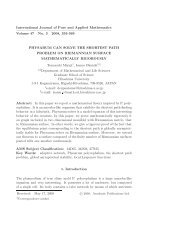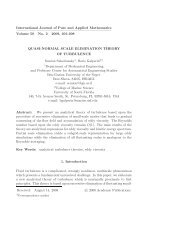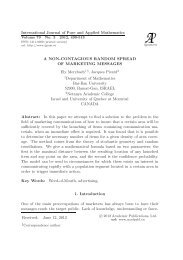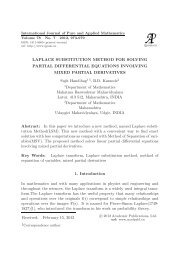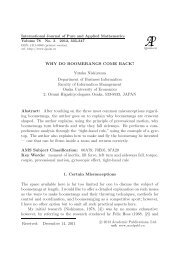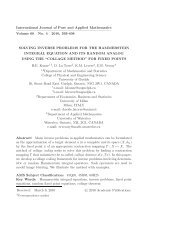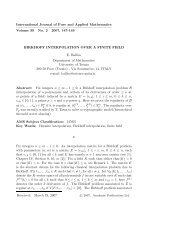REMARKS ON FRITZ JOHN CONDITIONS FOR PROBLEMS WITH ...
REMARKS ON FRITZ JOHN CONDITIONS FOR PROBLEMS WITH ...
REMARKS ON FRITZ JOHN CONDITIONS FOR PROBLEMS WITH ...
- TAGS
- remarks
- fritz
- www.ijpam.eu
Create successful ePaper yourself
Turn your PDF publications into a flip-book with our unique Google optimized e-Paper software.
International Journal of Pure and Applied Mathematics<br />
————————————————————————–<br />
Volume 71 No. 4 2011, 643-657<br />
<strong>REMARKS</strong> <strong>ON</strong> <strong>FRITZ</strong> <strong>JOHN</strong> C<strong>ON</strong>DITI<strong>ON</strong>S <strong>FOR</strong><br />
<strong>PROBLEMS</strong> <strong>WITH</strong> INEQUALITY AND<br />
EQUALITY C<strong>ON</strong>STRAINTS<br />
Giorgio Giorgi<br />
Dipartimento di Economia Politica e Metodi Quantitativi<br />
University of Pavia<br />
5, via San Felice, 27100, Pavia, ITALY<br />
Abstract: This paper contains several remarks and results on the necessary<br />
optimality conditions of Fritz John type for a nonlinear programming problem<br />
with inequality and equality constraints. The first part is concerned with a<br />
simple and brief proof of the Fritz John conditions, proof which benefits from<br />
the use of the Bouligand tangent cone. The second part is concerned with<br />
the same problem, where a set constraint (which covers the constraints which<br />
cannot be expressed by means of neither equalities nor inequalities) is added.<br />
Several remarks and results are given to deepen the study of Fritz John type<br />
conditions for this case.<br />
AMS Subject Classification: 90C30, 90C46<br />
Key Words: Fritz John conditions, set constraint<br />
1. Introduction<br />
The Fritz John theorem is one of the most important results in mathematical<br />
programming. When there are, besides inequality constraints, also equality<br />
constraints, the existing proofs are usually quite long and intricated. This is<br />
the case, for example, of the paper of Mangasarian and Fromovitz (1967), perhaps<br />
the first paper dealing with this topic, of the book of Bazaraa and Shetty<br />
(1967) and of Bazaraa, Sherali and Shetty (1993), of the paper of Still and<br />
Streng (1996), etc. An interesting paper of McShane (1973) uses the penalty<br />
approach and therefore it is useful in those courses on optimization, where also<br />
the computational aspects are treated. A similar approach is adopted also by<br />
Received: May 17, 2011 c○ 2011 Academic Publications, Ltd.
644 G. Giorgi<br />
Bertsekas (1999). Pourciau (1980, 1982) presents a proof (that he considers<br />
elementary) based on the Lipschitz Fixed Point Theorem, ”a result familiar<br />
to undergraduates”. We do not agree on this point. Recently, Birbil, Frenk<br />
and Still (2007) have given a quite elementary proof of the Fritz John (and<br />
Karush-Kuhn-Tucker) conditions for a nonlinear programming problem with<br />
equality and/or inequality constraints. Their proof relies on some basic results<br />
in linear programming and the Bolzano-Weierstrass theorem for compact sets.<br />
In our opinion a fruitful approach, also in order to ”prepare the ground” for<br />
other basic questions of mathematical programming theory (constraint qualifications,<br />
Karush-Kuhn-Tucker conditions, etc.), comes from a systematic use of<br />
the Bouligand tangent cone and its properties.<br />
This note is organized as follows. In Section 2 we give a quite elementary<br />
and brief proof of the classical Fritz John Theorem for a nonlinear programming<br />
problem with both inequality and equality constraints and no abstract<br />
constraint. In Section 3 we make some considerations for a problem where,<br />
besides inequality and equality constraints, there is also an abstract constraint,<br />
i. e. a set constraint (which covers the constraints which cannot be expressed<br />
by means of neither equalities nor inequalities).<br />
We consider the following two optimization problems<br />
(P) minimizef(x)<br />
x∈S<br />
where<br />
S = {x ∈ Rn : gi(x) ≤ 0,i ∈ I = {1,...m} ,hj(x) = 0,<br />
j ∈ J = {1,...p} , p ≤ n},<br />
(P1) minimizef(x)<br />
x∈S1<br />
where S1 = S ∩ C, C being a subset of Rn .<br />
We suppose that f and every gi,i ∈ I, are differentiable at a feasible point<br />
x 0 of (P) or (P1) and that every hj,j ∈ J, is continuously differentiable in a<br />
neighbourhood of x 0 (we could assume weaker differentiability conditions, but<br />
we prefer to adopt a classical approach).<br />
Definition 1. Let x 0 ∈ S; the cone<br />
K(x 0 ) = � y ∈ R n : ∇gi(x 0 )y ≤ 0, ∀i ∈ I(x 0 ); ∇hj(x 0 )y = 0, ∀j ∈ J � ,<br />
where I(x 0 ) = � i ∈ I : gi(x 0 ) = 0 � is the active index set at x 0 , is called the<br />
linearizing cone at x 0 for (P).<br />
The cone<br />
K 0 (x 0 ) = � y ∈ R n : ∇gi(x 0 )y < 0, ∀i ∈ I(x 0 ); ∇hj(x 0 )y = 0, ∀j ∈ J �
<strong>REMARKS</strong> <strong>ON</strong> <strong>FRITZ</strong> <strong>JOHN</strong> C<strong>ON</strong>DITI<strong>ON</strong>S <strong>FOR</strong>... 645<br />
is called the weak linearizing cone at x 0 or cone of the decreasing directions at<br />
x 0 for (P).<br />
A basic tool for treating optimality conditions for (P) or (P1) is some local<br />
cone approximation of a set S at a point x 0 ∈ S (or also x 0 ∈ clS). See, for<br />
example, Bazaraa and Shetty (1976), Aubin and Frankowska (1990), Giorgi,<br />
Gurraggio and Thierfelder (2004), Giorgi and Guerraggio (1992, 2002).<br />
Definition 2. A sequence � x k� ⊂ R n � � x 0� , with x k −→ x 0 is said to<br />
converge to x 0 in the direction y ∈ R n if it holds<br />
x<br />
lim<br />
k − x0 �xk − x0 = y.<br />
�<br />
k→∞<br />
Definition 3. Given a set S ⊂ Rn and a point x0 ∈ S (or also x0 ∈ clS),<br />
the cone<br />
T(S,x 0 �<br />
) = λy ∈ R n �<br />
: ∃ x k� x<br />
⊂ S, lim<br />
k→∞<br />
k − x0 �xk − x0 �<br />
= y,λ ≥ 0<br />
�<br />
is called the Bouligand tangent cone to S at x 0 or also the contingent cone to<br />
S at x 0 .<br />
It is well known that the contingent cone is a closed cone, but in general<br />
not convex. If x 0 is an isolated point of S, then T(S,x 0 ) = {0}. The contingent<br />
cone T(S,x 0 ) can be described in various alternative forms, e. g.,<br />
T(S,x 0 ) =<br />
�<br />
y ∈ R n �<br />
: ∃ x k�<br />
⊂ S, ∃λk ⊂ R+<br />
such that x k → x 0 ,λk(x k − x 0 ) → y<br />
T(S,x 0 ) = {y ∈ R n : ∀N(y), ∀λ > 0, ∃t ∈ (0,λ), ∃¯y ∈ N(y)<br />
�<br />
,<br />
such that x + t¯y ∈ S}.<br />
T(S,x 0 ) depends only on the structure of S around the point x 0 , i. e. if U(x 0 )<br />
is any neighborhood of x 0 , we have T(S,x 0 ) = T(S ∩ U(x 0 ),x 0 ). Moreover, if<br />
S is a convex set, it holds<br />
T(S,x 0 ) = cl cone(S − x 0 ),<br />
where cone S is the convex cone generated by S.
646 G. Giorgi<br />
We recall the Motzkin theorem of the alternative (see, e. g., Giorgi, Guerraggio<br />
and Thierfelder (2004), Mangasarian (1969)).<br />
Theorem 4. Let be given the matrices A,B and C. The following system<br />
Ay < 0,By ≤ 0,Cy = 0<br />
is impossible if and only if there exist vectors u ≥ 0,u �= 0,v ≥ 0 and w<br />
(sign-free) such that<br />
uA + vB + wC = 0.<br />
2. Fritz John Necessary Conditions for Problem (P)<br />
Theorem 5. (Fritz John Theorem) Let x 0 ∈ S be a local solution for<br />
(P), where f and every gi,i ∈ I, are differentiable at x 0 and every hj,j ∈ J, is<br />
continuously differentiable in a neighborhood of x 0 . Then there exist multipliers<br />
u0,u1,...,um ≥ 0 and v1,...,vp, not all zero, such that<br />
u0∇f(x 0 ) +<br />
m�<br />
ui∇gi(x 0 ) +<br />
i=1<br />
p�<br />
vj∇hj(x 0 ) = 0,<br />
j=1<br />
uigi(x 0 ) = 0, ∀i ∈ I.<br />
For the proof of this theorem we need some preliminary results, whose utility<br />
is also ”autonomous” for other questions of nonlinear programming. The next<br />
lemma is proved in many books and papers (see, e. g., Hestenes (1975), Gould<br />
and Tolle (1971), Varaiya (1967), Guignard (1969), Bazaraa and Shetty (1976))<br />
and is a basic result for optimization problems with only a set constraint. The<br />
proof is easy and very brief and will not be repeated here.<br />
Lemma 6. Let x 0 be a local solution of the problem<br />
minimizef(x)<br />
x∈C<br />
where f is differentiable on an open set containing C ⊂ R n . Then it holds<br />
∇f(x 0 )y ≥ 0, ∀y ∈ T(C,x 0 ).
<strong>REMARKS</strong> <strong>ON</strong> <strong>FRITZ</strong> <strong>JOHN</strong> C<strong>ON</strong>DITI<strong>ON</strong>S <strong>FOR</strong>... 647<br />
as<br />
We note that the thesis of the above lemma can be equivalently formulated<br />
−∇f(x 0 ) ∈ � T(C,x 0 ) � ∗<br />
where A ∗ is the (negative) polar cone of the set A ⊂ R n .<br />
Lemma 7. Let x 0 ∈ S and let f,gi,i ∈ I, and hj,j ∈ J, verify the<br />
assumptions of Theorem 5. Then we have:<br />
a) T(S,x 0 ) ⊂ K(x 0 );<br />
b) If the Jacobian matrix ∇h(x 0 ) has full rank, it holds K 0 (x 0 ) ⊂ T(S,x 0 );<br />
c) If, moreover, K(x 0 ) �= ∅, then it holds K(x 0 ) ⊂ T(S,x 0 ) = clK 0 (x 0 ).<br />
Proof. First of all note that, given relation a), condition c) entails the<br />
equality K(x 0 ) = T(S,x 0 ).<br />
a) The proof of this part can be found, e. g., in Bazaraa and Shetty (1976)<br />
and will not be repeated here. Anyhow, the proof is very brief and easy; moreover,<br />
this relation is not essential for the proof of Theorem 5.<br />
b) and c). First we prove c) for a particular case, i. e. we consider the<br />
”classical” case of no inequality constraints, i. e. the constraint set is<br />
S0 = {x ∈ R n : hj(x) = 0,j = 1,...p} ,<br />
where hj,j ∈ J, is continuously differentiable in a neighbourhood of x0 and the<br />
vectors ∇hj(x0 ),j ∈ J, are linearly independent. K0 (x0 ) is defined accordingly.<br />
By the Implicit Function Theorem, we can solve the nonlinear system h(x) = 0<br />
in a neighborhood of x0 , expressing p ”basic variables” as a function of the<br />
remaining n − p ”non basic variables”: xB = H(xNB). We have also, for H :<br />
Rn−p −→ Rp ,<br />
∇H(x 0 NB) = −(∇NBh(x 0 ))(∇Bh(x 0 )) −1.<br />
� �<br />
yB<br />
For a vector y = ∈ K<br />
yNB<br />
0 (x0 ) we have therefore<br />
∇h(x 0 )y = ∇Bh(x 0 )yB + ∇NBh(x 0 )yNB = 0,<br />
equivalent to yB = ∇H(x0 NB )yNB. We suppose yNB �= 0 (otherwise also yB = 0<br />
and the thesis would be trivial). Without loss of generality we suppose also<br />
�yNB� = 1. There exists therefore a sequence � xk �<br />
NB of non basic variables<br />
which converges to x0 NB in the direction yNB. But then it is also convergent
648 G. Giorgi<br />
the sequence � xk �<br />
B of the corresponding basic variables, with xk B = H(xk NB ),<br />
to x0 B = H(x0 NB ). The sequence<br />
�<br />
x k�<br />
��<br />
xk = B<br />
xk NB<br />
��<br />
=<br />
�� H(x k NB<br />
x k NB<br />
��<br />
is then feasible and convergent to x 0 in the direction y/�y�, as<br />
and<br />
x k NB − x0 NB<br />
�xk NB − x0 −→ yNB<br />
NB� H(x k NB ) − H(x0 NB )<br />
�x k NB − x0 NB �<br />
−→ ∇H(x 0 NB )yN = yB.<br />
Therefore we have proved that y ∈ T(S,x 0 ). Now we prove b). We suppose<br />
I(x 0 ) �= ∅, otherwise we would get K 0 (x 0 ) = K(x 0 ) and the thesis follows from<br />
what proved above. Let y ∈ K 0 (x 0 ), with �y� = 1, so this vector belongs (being<br />
∇hj(x 0 )y = 0, ∀j ∈ J and thanks to what proved above) to the tangent cone of<br />
the set � x ∈ R n : hj(x 0 ) = 0,j ∈ J � , formed of only equality constraints. That<br />
is, there exists a sequence � x k� in this set, which converges to x 0 in the direction<br />
y. Then, for what regards the active inequality contraints at x 0 , the expression<br />
gi(xk ) − gi(x0 )<br />
�xk − x0� = ∇gi(x0 )(xk − x0 ) + o(�xk − x0�) �xk − x0� converges to ∇gi(x 0 )y < 0, it holds also gi(x k ) < 0 for all k ∈ N sufficiently<br />
large. For the non active constraints at x 0 the same inequality holds, thanks to<br />
continuity. The sequence � x k� is therefore (for large values of k ∈ N) feasible.<br />
So we have proved that y ∈ T(S,x 0 ). Now we complete the proof of c), even<br />
if this statement is not essential to the proof of Theorem 5. Obviously we<br />
have K 0 (x 0 ) ⊂ K(x 0 ) and therefore clK 0 (x 0 ) ⊂ K(x 0 ). Now we prove that<br />
in fact we have equality. Let y ∈ K(x 0 ) and let us consider ¯y ∈ K 0 (x 0 )<br />
(K 0 (x 0 ) �= ∅ by assumption). By defining y k = y + (1/k)¯y, we construct a<br />
sequence � y k� of elements of K 0 (x 0 ) converging to y for k −→ ∞. Therefore<br />
y ∈ clK 0 (x 0 ). We have therefore that clK 0 (x 0 ) = K(x 0 ). Thanks to a), the<br />
equality T(S,x 0 ) = K(x 0 ) is proved if K 0 (x 0 ) ⊂ T(S,x 0 ). But this is just<br />
relation b), proved above. �<br />
Remark 8. The condition<br />
K 0 (x 0 ) �= ∅, ∇h(x 0 ) of full rank
<strong>REMARKS</strong> <strong>ON</strong> <strong>FRITZ</strong> <strong>JOHN</strong> C<strong>ON</strong>DITI<strong>ON</strong>S <strong>FOR</strong>... 649<br />
is the well-known Mangasarian-Fromovitz constraint qualification, which assures<br />
that in Theorem 5 it holds u0 > 0. Moreover, this constraint qualification<br />
is both necessary and sufficient for the set (u0,u1,...,um,v1,...,vp) of Fritz John<br />
multipliers to be bounded and is necessary and sufficient in order that in all<br />
elements of the same set, it holds u0 > 0.<br />
Proof of Theorem 5. If the vectors � ∇h1(x 0 ),...∇hp(x 0 ) � are linearly dependent,<br />
the thesis follows trivially. So, let ∇h(x 0 ) be of full rank. Being<br />
x 0 ∈ S a local solution of (P), thanks to Lemmas 6 and 7 (part b)), we have<br />
∇f(x 0 )y ≥ 0, ∀y ∈ T(S,x 0 ) ⊃ K 0 (x 0 ). It will be ∇f(x 0 )y ≥ 0 for all y such<br />
that<br />
That is, the system<br />
∇gi(x 0 )y < 0, i ∈ I(x 0 ),<br />
∇hj(x 0 )y = 0, j ∈ J.<br />
⎧<br />
⎨<br />
⎩<br />
∇f(x 0 )y < 0,<br />
∇gi(x 0 )y < 0, i ∈ I(x 0 ),<br />
∇hj(x 0 )y = 0, j ∈ J,<br />
has no solution y ∈ R n . Apply Theorem 4 (Motzkin alternative theorem) and<br />
put ui = 0, ∀i /∈ I(x 0 ), to obtain at once the thesis. �<br />
3. Fritz John Necessary Conditions for Problem (P1)<br />
When, as in problem (P1), besides inequality and equality constraints, there is<br />
also a set constraint C ⊂ R n , with C not open, the classical Fritz John necessary<br />
conditions of Theorem 5 are no longer valid. Bazaraa and Shetty (1976) provide<br />
a counterexample; the conditions of Theorem 5 must be modified, obtaining<br />
(with suitable additional assumptions) necessary optimality conditions of the<br />
so-called ”minimum principle type” (also called from some authors ”generalized<br />
Lagrange multipliers rule”).<br />
Definition 9. Let x 0 ∈ S ⊂ R n . The set<br />
I(S,x 0 ) = {y ∈ R n : ∃N(y), ∃λ > 0 such that<br />
� ∀t ∈ (0,λ), ∀v ∈ N(y) : x 0 + tv ∈ S �
650 G. Giorgi<br />
is called the cone of interior directions to S at x 0 . The set<br />
Q(S,x 0 ) = {y ∈ R n : ∃N(y)such that∀δ > 0 ∃t ∈ (0,δ)such that<br />
∀v ∈ N(y) : x 0 + tv ∈ S �<br />
is called the cone of quasi-interior directions to S at x 0 .<br />
Both these cones are open and it holds I(S,x 0 ) ⊂ Q(S,x 0 ) ⊂ T(S,x 0 ).<br />
Moreover, I(S,x 0 ) and Q(S,x 0 ) are nonempty if intS �= ∅. If S is a convex set<br />
we have<br />
I(S,x 0 ) = Q(S,x 0 ) = cone(intS − x 0 ).<br />
If, moreover, intS �= ∅, then<br />
I(S,x 0 ) = intT(S,x 0 ),<br />
T(S,x 0 ) = clI(S,x 0 ) = cl cone(S − x 0 ).<br />
See, e.g., Aubin and Frankowska (1990), Giorgi, Guerraggio and Thierfelder<br />
(2004), Giorgi and Guerraggio (2002). We recall that, given a set A ⊂ R n , A ∗<br />
is the (negative) polar cone of A.<br />
Bazaraa and Goode (1972) (see also Bazaraa abd Shetty(1976)) prove the<br />
following result.<br />
Theorem 10. Let x0 be a local solution of (P1) and let the assumptions<br />
of Theorem 2 be verified. Moreover, let I(C,x0 ) be convex. Then there exist<br />
scalars u0,u1,...,um ≥ 0 and v1,...,vp, not all zero, such that<br />
�<br />
− u0∇f(x0 ) + �m i=1 ui∇gi(x0 ) + �p j=1 vj∇hj(x0 �<br />
) ∈ I∗ (C,x0 )<br />
uigi(x 0 ) = 0, ∀i ∈ I.<br />
Remark 11. Giorgi and Guerraggio (1994) give a sharper result, as they<br />
prove Theorem 10 with I(C,x 0 ) substituted by the larger cone Q(C,x 0 ). However,<br />
it is not possible, in general, to replace the open cones I(C,x 0 ) or Q(C,x 0 )<br />
by the larger, but closed cone, T(C,x 0 ). Counterexamples can be given.<br />
Remark 12. We have seen that I(C,x 0 ) or Q(C,x 0 ) are convex if C is<br />
a convex set. More generally: a set X ⊂ is locally convex at x 0 ∈ X if there<br />
exists a neighborhood N(x 0 ) such that X ∩ N(x 0 ) is convex. Then I(C,x 0 ) or<br />
Q(C,x 0 ) are convex if C is locally convex at x 0 (the same holds for other local<br />
cone approximations).<br />
Now, let us consider a nonlinear programming problem with a set constraint<br />
but with no equality constraints, i. e.
<strong>REMARKS</strong> <strong>ON</strong> <strong>FRITZ</strong> <strong>JOHN</strong> C<strong>ON</strong>DITI<strong>ON</strong>S <strong>FOR</strong>... 651<br />
(P2) minimizef(x),<br />
x∈S2<br />
where S2 = {x ∈ Rn : gi(x) ≤ 0,i ∈ I} ∩ C.<br />
Giorgi and Guerraggio (1994) prove the following result.<br />
Theorem 13. Let x 0 be a local solution of (P2), where f and every gi,i ∈ I,<br />
are differentiable at x 0 . Then, there exist scalars λ0 ≥ 0,λi ≥ 0,i ∈ I, not all<br />
zero, such that<br />
− � λ0∇f(x 0 ) + � m<br />
i=1 λi∇gi(x 0 ) � ∈ T ∗ 1 (C,x0 )<br />
λigi(x 0 ) = 0, ∀i ∈ I,<br />
where T1(C,x 0 ) is a convex subcone of T(C,x 0 ).<br />
If T(C,x 0 ) is a convex cone, Theorem 13 gives a sharper result than Theorem<br />
10. This is not surprising, as (P1) comtains also equality constraints. If<br />
T(C,x 0 ) is not a convex cone, there exist several convex subcones of the same,<br />
that can be chosen to represent T1C,x 0 ). It is well known that one of these<br />
convex cones is the Clarke tangent cone to x 0 ∈ C :<br />
TCl(C,x 0 ) = � y ∈ R n : ∀N(y)∃λ > 0, ∃V (x 0 ), ∀¯x ∈ V (x 0 ) ∩ C,<br />
In terms of sequences:<br />
∀t ∈ (0,λ)∃¯y ∈ N(y) : ¯x + t¯y ∈ C}.<br />
TCl(C,x 0 ) = � y ∈ R n : ∀tn −→ 0 + , ∀x n −→ x 0 with<br />
x n ∈ C, ∃y n −→ y such that x n + tny n ∈ C, ∀n ∈ N}.<br />
Obviously, if we can choose the largest convex subcone of T(C,x 0 ), Theorem<br />
13 will be sharper. Theorem 13 can be justified as follows.<br />
If we consider (P2), with T(C,x 0 ) convex, e. g. because C is convex, we<br />
have obviously<br />
x 0 minimum for (P2) =⇒ ∇f(x 0 )y ≥ 0, ∀y ∈ T(S2,x 0 ).<br />
Now we can use the simple inclusion<br />
T(C,x 0 ) ∩ � y ∈ R n : ∇gi(x 0 )y < 0, ∀i ∈ I(x 0 ) � ⊂ T(S2,x 0 )<br />
which holds true, since the second set is open. So we get<br />
∇f(x 0 )y ≥ 0, ∀y ∈ T(C,x 0 ) ∩ � y ∈ R n : ∇gi(x 0 )y < 0,i ∈ I(x 0 ) �
652 G. Giorgi<br />
which is equivalent to<br />
� y : ∇f(x 0 )y < 0, ∇gi(x 0 )y < 0,i ∈ I(x 0 ) � ∩ T(C,x 0 ) = ∅.<br />
If the first set is empty, we get the classical Fritz John conditions by the<br />
Gordan theorem of the alternative (see, e.g., Mangasarian (1969)). If the first<br />
set is not empty, then, by the classical separation theorem (the first set is open!),<br />
we get the existence of non negative and not all zero multipliers such that<br />
⎡<br />
− ⎣λ0∇f(x 0 ) + �<br />
λi∇gi(x 0 ) ∈ T ∗ (C,x 0 ⎤<br />
) ⎦ .<br />
i∈I(x 0 )<br />
If we take (P1) into consideration we have in general (even assuming that<br />
C is convex)<br />
∇hj(x 0 )y = 0,j ∈ J � �⊂ T(S1,x 0 ),<br />
T(C,x 0 ) ∩ � y ∈ R n : ∇gi(x 0 )y < 0, ∀i ∈ I(x 0 ),<br />
as the second set in this last relation is not open.<br />
The results of Bazaraa and Goode (1972) and of Giorgi and Guerraggio<br />
(1994) for (P1) have been subsequently generalized, with regard to a vector<br />
optimization problem, by Giorgi, Jimenez and Novo (2004). We report here<br />
their Theorem 4.1, referred to (P1) and to the differentiability assumptions for<br />
(P1).<br />
Theorem 14. Let x 0 be a local solution of (P1) and let the assumptions<br />
of Theorem 5 be verified. Moreover, let P ⊂ R n be a convex set with 0 ∈ P<br />
and let the following regularity condition hold<br />
(RC) ker ∇h(x 0 ) ∩ P ⊂ T(H ∩ C,x 0 ),<br />
whereH = {x ∈ R n : h(x) = 0} .<br />
Thenthereexists (u0,u,v) such that (u0,u) ≥ 0, (u0,u,v) �= 0 and<br />
�<br />
− u0∇f(x0 ) + �m i=1 ui∇gi(x0 ) + �p j=1 vj∇hj(x0 �<br />
) ∈ P ∗<br />
uigi(x 0 ) = 0, ∀i ∈ I.<br />
Remark 15. We obtain the same conclusione for P = I(C,x 0 ) ∪ {0} or<br />
P = Q(C,x 0 ) ∪ {0} without assuming (RC). That is, I(C,x 0 ) or Q(C,x 0 ) are<br />
assumed to be convex, as in Theorem 10 or in its generalization by Giorgi and<br />
Guerraggio (1994).
<strong>REMARKS</strong> <strong>ON</strong> <strong>FRITZ</strong> <strong>JOHN</strong> C<strong>ON</strong>DITI<strong>ON</strong>S <strong>FOR</strong>... 653<br />
Mangasarian (1969), assuming that C is closed and convex and intC �= ∅,<br />
obtains for (P1) the following ”minimum principle type conditions”:<br />
⎡<br />
⎣u0∇f(x 0 m�<br />
) + ui∇gi(x 0 p�<br />
) + vj∇hj(x 0 ⎤<br />
) ⎦ (x − x 0 ) ≥ 0, ∀x ∈ C,<br />
i=1<br />
j=1<br />
in addition to the usual sign conditions on the multipliers and the complementarity<br />
conditions. The same relations are obtained by Jahn (1994), always<br />
under the assumptions of C convex, intC �= ∅, for a more general problem.<br />
This is a corollary of Theorem 10, as, if intC �= ∅ (C convex), we have seen<br />
that T(C,x 0 ) = clI(C,x 0 ) = clQ(C,x 0 ). In this case the polar of the Bouligand<br />
tangent cone T(C,x 0 ) is the so-called normal cone to the convex set C at x 0 :<br />
N(C,x 0 ) = � T(C,x 0 ) � ∗ = � clcone(C − x 0 ) � ∗ = (C − x 0 ) ∗ .<br />
If intC = ∅, then I(C,x 0 ) = Q(C,x 0 ) = ∅ and Theorem 10 holds trivially.<br />
On the other hand, some authors, e. g., Robinson (1976), Giorgi, Jimenez<br />
and Novo (2004), obtain the Mangasarian minimum principle type conditions<br />
merely under the convexity of C, without imposing intC �= ∅. This result,<br />
however, seems to be not directly deducible from Theorem 10 or even from<br />
Theorem 14, unless J = ∅ (Theorem 13).<br />
In a quite recent paper Bertsekas and Ozdaglar (2002) consider problem<br />
(P1), with C nonempty closed set of R n and with f, every gi and every hj continuously<br />
differentiable functions from R n to R. They obtain “enhanced” Fritz<br />
John type conditions, where, instead of looking for a local cone approximation<br />
of C whose polar is suitable to get a minimum principle type condition, they<br />
use directly a generalization of the normal cone to C at x 0 . See also Bertzekas,<br />
Ozdaglar and Tseng (2005). Similarly for what concerns the various tangent<br />
cones proposed in the literature, there are various definitions of normal cones.<br />
Here we refer to what may be called the general normal cone to C at x 0 ∈ C or<br />
Mordukhovich normal cone to C at x 0 ∈ C (see Mordukhovich (1976), Rockafellar<br />
(1993), Rockafellar and Wets (1998)). This cone, denoted NM(C,x 0 ),<br />
consists of all vectors v ∈ R n for which there is a sequence of vectors v n −→ v<br />
and a sequence of points x n −→ x 0 in C, such that, for each n,<br />
v n (x − x n ) ≤ o(�x − x n �), ∀x ∈ C.<br />
Rockafellar and Wets (1998) prove that v ∈ NM(C,x 0 ) if and only if there<br />
exist sequences {x n } ⊂ C and {v n } such that x n −→ x 0 ,v n −→ v and v n ∈<br />
[T(C,x n )] ∗ for all n. NM(C,x 0 ) is a closed cone, but in general not convex;
654 G. Giorgi<br />
in general we have [T(C,x n )] ∗ ⊂ NM(C,x 0 ), however, NM(C,x 0 ) may not be<br />
equal to [T(C,x n )] ∗ . When C is convex we have<br />
[T(C,x n )] ∗ = NM(C,x 0 ) = N(C,x 0 ).<br />
Bertsekas and Ozdaglar (2002), besides other properties here not considered,<br />
obtain the following version of a generalized Fritz John Theorem.<br />
Theorem 16. Let x0 be a local solution of (P1), where f, every gi and<br />
every hj are continuously differentiable and C is a nonempty closed set of Rn .<br />
Then there exist multipliers (u0,u,v) such that (u0,u) ≥ 0, (u0,u,v) �= 0 and<br />
�<br />
− u0∇f(x0 ) + �m i=1 ui∇gi(x0 ) + �p j=1 vj∇hj(x0 �<br />
) ∈ NM(C,x 0 )<br />
uigi(x 0 ) = 0, ∀i ∈ I.<br />
We note that, when C is convex, we obtain, as a corollary, the minimum<br />
prin- ciple type condition of Mangasarian, apart from being intC �= ∅ or intC =<br />
∅.<br />
Remark 17. In a pioneering paper Clarke (1976) presented the following<br />
generalized Lagrange multiplier rule for (P1), where f, every gi and every hj,<br />
are supposed to be locally Lipschitz at x 0 and C is a closed subset of R n : if x 0<br />
solves (P1) locally, then there exist numbers (u0,ui,vj) (i = 1,...,m;j = 1,...,p)<br />
not all zero, such that (u0,u) ≥ 0 and such that<br />
0 ∈ � u0∂Clf(x 0 ) + �m + �p j=1 vj∂Clhj(x 0 ) + NCl(C,x 0 �<br />
) ,<br />
uigi(x 0 ) = 0, ∀i ∈ I.<br />
i=1 ui∂Clgi(x 0 )+<br />
Here ∂Clf(x 0 ) is the Clarke subdifferential of f at x 0 :<br />
∂Clf(x 0 ) = � ξ ∈ R n : (ξ, −1) ∈ NCl(epif,(x 0 ,f(x 0 ))) �<br />
and NCl(C,x 0 ) is the Clarke normal cone of C at x 0 : NCl(C,x 0 ) = � TCl(C,x 0 ) � ∗ .<br />
It is known (see, e.g., Clarke (1983)) that if for each point in a neighborhood<br />
of x 0 , f is continuously differentiable, then ∂Clf(x 0 ) = � ∇f(x 0 ) � . So, in this<br />
case, we have another classical minimum type optimality condition for (P1).<br />
Moreover, if C is also convex, again we obtain, as a corollary, the minimum<br />
principle type condition of Mangasarian, without imposing intC �= ∅, being in<br />
this case,<br />
TCl(C,x 0 ) = T(C,x 0 ) and N(C,x 0 ) = NCl(C,x 0 ) = (C − x 0 ) ∗ .
<strong>REMARKS</strong> <strong>ON</strong> <strong>FRITZ</strong> <strong>JOHN</strong> C<strong>ON</strong>DITI<strong>ON</strong>S <strong>FOR</strong>... 655<br />
References<br />
[1] J.P. Aubin, H. Frankowska, Set-Valued Analysis , Birkhäuser, Boston<br />
(1990).<br />
[2] M.S. Bazaraa, J.J. Goode, Necessary optimality criteria in mathematical<br />
programming in the presence of differentiability, J. Math. Anal. Appl., 40<br />
(1972), 609-621.<br />
[3] M.S. Bazaraa, C.M. Shetty, Foundations of Optimization, Springer Verlag,<br />
Berlin (1976).<br />
[4] M.S. Bazaraa, H.D. Sherali, C.M. Shetty, Nonlinear Programming. Theory<br />
and Algorithms, John Wiley & Sons, New York (1993).<br />
[5] D.P. Bertsekas, Nonlinear Programming, 2-nd Edition, Athena Scientific,<br />
Belmont, Mass (1999).<br />
[6] D.P. Bertsekas, A.E. Ozdaglar, Pseudonormality and Lagrange multiplier<br />
theory for constrained optimization, J. Optim. Theory Appl., 114 (2002),<br />
287-343.<br />
[7] D.P. Bertsekas, A.E. Ozdaglar, P. Tseng, Enhanced Fritz John conditions<br />
for convex programming, SIAM J. Optim., 16 (2005), 766-797.<br />
[8] S.I. Birbil, J.B. G. Frenk, G.J. Still, An elementary proof of the Fritz-John<br />
and Karush-Kuhn-Tucker conditions in nonlinear programming, European<br />
J. of Operational Res., 180 (2007), 479-484.<br />
[9] F.H. Clarke, A new approach to Lagrange multipliers, Math. Oper. Res.,<br />
1 (1976), 165-174.<br />
[10] F.H. Clarke, Optimization and Nonsmooth Analysis, John Wiley & Sons,<br />
New York (1983).<br />
[11] G. Giorgi, A. Guerraggio, On the notion of tangent cone in mathematical<br />
programming, Optimization, 25 (1992), 11-23.<br />
[12] G. Giorgi, A. Guerraggio, First order generalized optimality conditions<br />
for programming problems with a set constraint, In: Generalized Convexity<br />
(Ed-s: S. Komlosi, T. Rapcsàk and S. Schaible), Proceedings, Pécs,<br />
Hungary, 1992, Springer Verlag, Berlin (1994), 171-185.
656 G. Giorgi<br />
[13] G. Giorgi, A. Guerraggio, Characterizations, comparisons, algebraic and<br />
topological properties of tangent cones, Journal of Statistics and Management<br />
Systems, 5 (2002), 275-294.<br />
[14] G. Giorgi, A. Guerraggio, J Thierfelder, Mathematics of Optimization.<br />
Smooth and Nonsmooth Case, Elsevier, Amsterdam (2004).<br />
[15] G. Giorgi, B. Jimenez, V. Novo, Minimum principle-type optimality conditions<br />
for Pareto problems, Int. Journal of Pure and Applied Mathematics,<br />
10 (2004), 51-68.<br />
[16] F.J. Gould, J. Tolle, A necessary and sufficient condition for constrained<br />
optimization, SIAM Journal on Applied Mathematics, 20 (1971), 164-172.<br />
[17] M. Guignard, Generalized Kuhn-Tucker conditions for mathematical programming<br />
in a Banach space, SIAM Journal on Control, 7 (1969), 232-241.<br />
[18] M.R. Hestenes, Optimization Theory: The Finite-Dimensional Case, John<br />
Wiley, New York (1975).<br />
[19] J. Jahn, Introduction to the Theory of Nonlinear Optimization, Springer<br />
Verlag, Berlin (1994).<br />
[20] O.L. Mangasarian, Nonlinear Programming, McGraw-Hill, New York<br />
(1969).<br />
[21] O.L. Mangasarian, S. Fromovitz, The Fritz John necessary optimality conditions<br />
in the presence of equality and inequality constraints, J. Math.<br />
Anal. Appl., 17 (1967), 37-47.<br />
[22] E.J. McShane, The Lagrange multiplier rule, Amer. Math. Monthly, 80<br />
(1973), 922-925.<br />
[23] B. Mordukhovich, Maximum principle in the problem of time optimal response<br />
with nonsmooth constraints, Journal of Applied Mathematics and<br />
Mechanics, 40 (1976), 960-969.<br />
[24] B.H. Pourciau, Modern multiplier rules, Amer. Math. Monthly, 87 (1980),<br />
433-452.<br />
[25] B.H. Pourciau, On the Carathéodory-John multiplier rule, J. Math. Anal.<br />
Appl., 87 (1982), 373-381.
<strong>REMARKS</strong> <strong>ON</strong> <strong>FRITZ</strong> <strong>JOHN</strong> C<strong>ON</strong>DITI<strong>ON</strong>S <strong>FOR</strong>... 657<br />
[26] S.M. Robinson, First order conditions for general nonlinear optimization,<br />
SIAM J. Appl. Math., 30 (1976), 597-607.<br />
[27] R.T. Rockafellar, Lagrange multipliers and optimality, SIAM Review, 35<br />
(1993), 183-238.<br />
[28] R.T. Rockafellar, R.-J. Wets, Variational Analysis, Springer, Berlin (1998).<br />
[29] G. Still, M. Streng, Optimality conditions in smooth nonlinear programming,<br />
J. Optim. Theory Appl., 90 (1996), 483-515.<br />
[30] O. Varaiya, Nonlinear programming in Banach spaces, SIAM Journal on<br />
Applied Mathematics, 15 (1967), 147-152.
658



